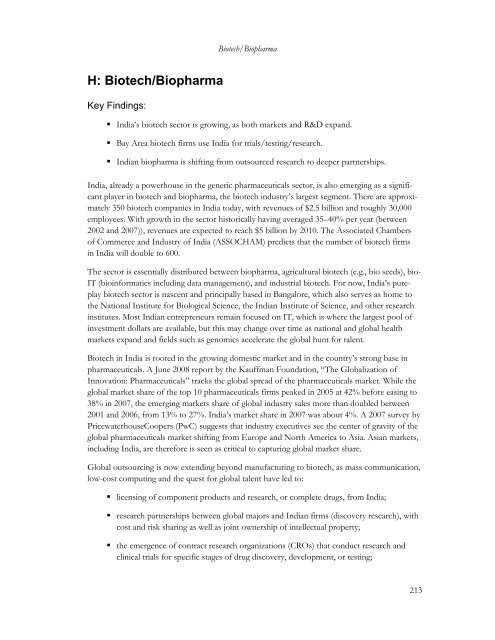PDF: 2962 pages, 5.2 MB - Bay Area Council Economic Institute
PDF: 2962 pages, 5.2 MB - Bay Area Council Economic Institute
PDF: 2962 pages, 5.2 MB - Bay Area Council Economic Institute
You also want an ePaper? Increase the reach of your titles
YUMPU automatically turns print PDFs into web optimized ePapers that Google loves.
Biotech/Biopharma<br />
H: Biotech/Biopharma<br />
Key Findings:<br />
• India’s biotech sector is growing, as both markets and R&D expand.<br />
• <strong>Bay</strong> <strong>Area</strong> biotech firms use India for trials/testing/research.<br />
• Indian biopharma is shifting from outsourced research to deeper partnerships.<br />
India, already a powerhouse in the generic pharmaceuticals sector, is also emerging as a significant<br />
player in biotech and biopharma, the biotech industry’s largest segment. There are approximately<br />
350 biotech companies in India today, with revenues of $2.5 billion and roughly 30,000<br />
employees. With growth in the sector historically having averaged 35–40% per year (between<br />
2002 and 2007)), revenues are expected to reach $5 billion by 2010. The Associated Chambers<br />
of Commerce and Industry of India (ASSOCHAM) predicts that the number of biotech firms<br />
in India will double to 600.<br />
The sector is essentially distributed between biopharma, agricultural biotech (e.g., bio seeds), bio-<br />
IT (bioinformatics including data management), and industrial biotech. For now, India’s pureplay<br />
biotech sector is nascent and principally based in Bangalore, which also serves as home to<br />
the National <strong>Institute</strong> for Biological Science, the Indian <strong>Institute</strong> of Science, and other research<br />
institutes. Most Indian entrepreneurs remain focused on IT, which is where the largest pool of<br />
investment dollars are available, but this may change over time as national and global health<br />
markets expand and fields such as genomics accelerate the global hunt for talent.<br />
Biotech in India is rooted in the growing domestic market and in the country’s strong base in<br />
pharmaceuticals. A June 2008 report by the Kauffman Foundation, “The Globalization of<br />
Innovation: Pharmaceuticals” tracks the global spread of the pharmaceuticals market. While the<br />
global market share of the top 10 pharmaceuticals firms peaked in 2005 at 42% before easing to<br />
38% in 2007, the emerging markets share of global industry sales more than doubled between<br />
2001 and 2006, from 13% to 27%. India’s market share in 2007 was about 4%. A 2007 survey by<br />
PricewaterhouseCoopers (PwC) suggests that industry executives see the center of gravity of the<br />
global pharmaceuticals market shifting from Europe and North America to Asia. Asian markets,<br />
including India, are therefore is seen as critical to capturing global market share.<br />
Global outsourcing is now extending beyond manufacturing to biotech, as mass communication,<br />
low-cost computing and the quest for global talent have led to:<br />
• licensing of component products and research, or complete drugs, from India;<br />
• research partnerships between global majors and Indian firms (discovery research), with<br />
cost and risk sharing as well as joint ownership of intellectual property;<br />
• the emergence of contract research organizations (CROs) that conduct research and<br />
clinical trials for specific stages of drug discovery, development, or testing;<br />
213








